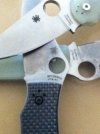Hurrul
Gold Member
- Joined
- Aug 26, 2017
- Messages
- 1,377
...that mythical knife steel that I would read about others experiencing...that super something that is portrayed as being as sharp after "hard use" as it was when the "hard use" started....
These days, after jumping onto various particle metal steal band wagons, or drinking one kool - aid after another, I have determined that some knives get dull after a day in the field, but, not all knives loose their edge after a day in the field, or a session of cardboard box breakdown.
To me, the greatest learning is that all edge holding longevity is determined by many reasons, no matter the notable maker/manufacturer working with the current notable steel.
Perhaps the terminology "dull" vs. "losing the edge" are used interchangeably with in the knife community/world? but, they don't mean exactly the same thing?
Thoughts?
These days, after jumping onto various particle metal steal band wagons, or drinking one kool - aid after another, I have determined that some knives get dull after a day in the field, but, not all knives loose their edge after a day in the field, or a session of cardboard box breakdown.
To me, the greatest learning is that all edge holding longevity is determined by many reasons, no matter the notable maker/manufacturer working with the current notable steel.
Perhaps the terminology "dull" vs. "losing the edge" are used interchangeably with in the knife community/world? but, they don't mean exactly the same thing?
Thoughts?


